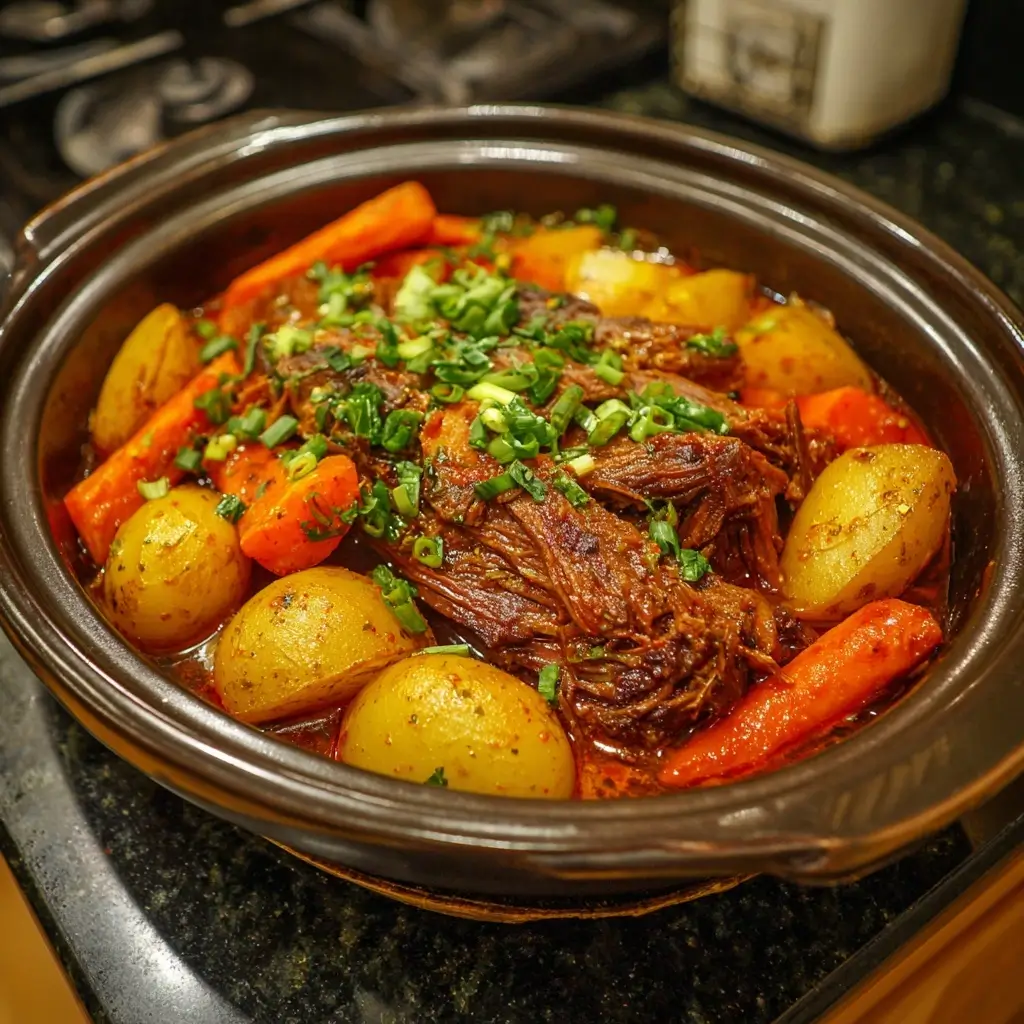Korean Style Pot Roast: A Comforting Classic with Deep Flavors
Korean Style Pot Roast, known as Galbijjim (갈비찜) or sometimes Jangjorim when made with beef brisket, is a beloved traditional dish that embodies the essence of Korean home cooking. This rich, savory-sweet braise combines tender cuts of beef with a deeply aromatic sauce made from soy sauce, garlic, ginger, and Asian pear, resulting in a melt-in-your-mouth experience that’s both comforting and elegant. Often served during holidays, family gatherings, or special occasions, Korean Pot Roast is more than just a meal—it’s a symbol of warmth, tradition, and shared heritage.
The History of Korean Style Pot Roast
The origins of Korean pot roast trace back to the royal courts of the Joseon Dynasty (1392–1897), where elaborate meals were prepared for royalty using premium ingredients and meticulous techniques. Dishes like Galbijjim were considered luxurious due to the use of high-quality beef and time-intensive preparation methods. Originally reserved for aristocrats and special celebrations, this braise evolved over centuries into a staple of Korean households. The word “jim” means “steamed” or “braised,” indicating the slow-cooking method essential to developing its signature tenderness and depth of flavor.
While Western-style pot roast relies heavily on root vegetables and wine-based broths, the Korean version distinguishes itself through its use of fermented seasonings such as soy sauce and garlic, along with natural sweeteners like Asian pear and honey. Over time, regional variations emerged across Korea—some versions include chestnuts, jujubes (Korean dates), and ginkgo nuts, adding layers of texture and symbolism related to prosperity and longevity. Today, Galbijjim remains a centerpiece dish at ancestral rites (jerye) and festive events like Chuseok (Korean Thanksgiving).
Ingredients Breakdown
The magic of Korean Style Pot Roast lies in its balance of umami, sweetness, saltiness, and subtle fruitiness. Each ingredient plays a crucial role in building complex flavors while tenderizing the meat. Here’s a detailed breakdown:
- Beef Short Ribs (Flanken Cut): Also known as cross-cut ribs, these are ideal because they contain bone, marrow, and marbled meat, which break down beautifully during long braising. Alternatives include chuck roast or brisket.
- Soy Sauce: Provides the foundational salty-umami base. Use ganjang (Korean soup soy sauce) if possible, or regular brewed soy sauce. Avoid dark Chinese soy sauce, which can be too intense.
- Asian Pear (Bae): A secret weapon in Korean cuisine, it naturally tenderizes meat thanks to enzymes like papain and adds a delicate sweetness without overpowering.
- Garlic & Ginger: Add aromatic depth and slight heat. Freshly minced or grated works best.
- Green Onions: Used both during cooking and as garnish for freshness and color contrast.
- Caster Sugar or Honey: Balances the saltiness. Honey adds floral notes; brown sugar gives a deeper molasses touch.
- Black Pepper: Whole peppercorns infuse mild spice without dominating.
- Water or Beef Broth: Forms the braising liquid. Homemade broth enhances richness.
- Sesame Oil: Drizzled at the end for nutty aroma and gloss.
- Optional Add-ins: Jujubes (daechu), chestnuts, carrots, shiitake mushrooms, ginkgo nuts—often included for texture, symbolism, and visual appeal.
Step-by-Step Recipe
Follow this detailed guide to create an authentic, restaurant-quality Korean Style Pot Roast at home.
Ingredients
- 2 lbs (900g) beef short ribs, flanken-cut (about 1-inch thick)
- 6 cups water or low-sodium beef broth
- 1 large Asian pear, peeled and grated
- 1 medium onion, sliced
- 10 cloves garlic, minced
- 1-inch piece fresh ginger, thinly sliced or grated
- ½ cup soy sauce (use gluten-free if needed)
- ¼ cup caster sugar (or 3 tbsp honey)
- 1 tbsp sesame oil
- 1 tsp black pepper (preferably freshly cracked)
- 6 green onions, cut into 2-inch pieces
- 4 dried jujubes (optional)
- 8–10 roasted chestnuts (peeled, optional)
- 1 large carrot, cut into thick rounds (optional)
- 4 dried shiitake mushrooms, rehydrated (optional)
- 8 ginkgo nuts (optional)
- Toasted sesame seeds, for garnish
Directions
- Parboil the Meat: Place the beef short ribs in a large pot and cover with cold water. Bring to a boil over high heat and simmer for 5 minutes to remove impurities and excess blood. Skim off any foam that rises to the surface. Drain and rinse the ribs under cold water. This step ensures a clean, clear broth and reduces gaminess.
- Prepare the Braising Liquid: In a clean heavy-bottomed pot or Dutch oven, combine 6 cups of water or broth, soy sauce, grated Asian pear, minced garlic, ginger, onion slices, sugar (or honey), black pepper, and sesame oil. Stir well until the sugar dissolves.
- Add the Meat: Return the parboiled ribs to the pot. Bring the mixture to a gentle boil, then reduce the heat to low. Cover and simmer slowly for 1.5 hours, skimming occasionally.
- Add Vegetables and Extras: After 1.5 hours, add the carrots, jujubes, chestnuts, shiitake mushrooms, ginkgo nuts, and half of the green onions. Stir gently to avoid breaking apart the tender meat. Continue to simmer uncovered for another 30–45 minutes, allowing the liquid to reduce into a glossy, syrupy glaze.
- Check for Doneness: The meat should pull easily from the bone, and the sauce should coat the back of a spoon. Taste and adjust seasoning—add a pinch more sugar if too salty, or a splash of water if too concentrated.
- Final Touch: Remove from heat. Drizzle with additional sesame oil and sprinkle with remaining green onions and toasted sesame seeds for fragrance and presentation.
- Serve Warm: Traditionally served over steamed white rice, accompanied by kimchi and side dishes (banchan).
Tips for Perfect Korean Pot Roast
- Use Fresh Asian Pear: Do not substitute with apple unless necessary—the enzymes in pear make a real difference in tenderization.
- Low and Slow is Key: Maintain a gentle simmer throughout. Boiling vigorously will toughen the meat.
- Skim Regularly: Removing scum early keeps your sauce clean and visually appealing.
- Reduce Uncovered at the End: This concentrates flavor and creates the signature sticky glaze without needing cornstarch.
- Make Ahead Advantage: Like many braises, Galbijjim tastes even better the next day. Reheat gently on the stove.
- Freezing Friendly: Cool completely and store in airtight containers for up to 3 months. Thaw overnight before reheating.
- Bone-In vs. Boneless: Bones add flavor and help retain moisture. If using boneless short ribs, reduce cooking time by 20–30 minutes.
Variations and Customizations
Korean cuisine embraces flexibility, and Galbijjim can be adapted based on dietary needs, availability, and personal taste:
- Vegetarian Version: Substitute beef with king oyster mushrooms or tofu skin rolls. Use mushroom broth and increase soy sauce and sweetness slightly.
- Spicy Galbijjim: Add 1–2 tbsp gochujang (Korean chili paste) or a few dried red chilies for heat.
- Fruit Variations: Try pineapple juice instead of pear for a tangier profile (note: don’t overcook, as bromelain can make meat mushy).
- Gluten-Free Option: Use tamari or certified gluten-free soy sauce.
- One-Pot Rice Bake: Once the meat is done, stir in rinsed short-grain rice and enough water to cook. Simmer covered for 20 minutes for a flavorful beef rice dish.
- Modern Twist: Finish with a splash of mirin or sake for added complexity, or top with microgreens for a contemporary look.
Health Considerations and Nutritional Value
While undeniably delicious, Korean Style Pot Roast is rich and should be enjoyed in moderation, especially for those monitoring sodium or calorie intake.
- Sodium Content: Soy sauce contributes significant sodium. To reduce, use reduced-sodium soy sauce and dilute with extra water or broth.
- Fat Management: Flanken-cut ribs have fat marbling that enriches flavor but increases saturated fat. Skim fat after chilling overnight, or opt for leaner cuts like eye of round (though less juicy).
- Natural Sweeteners: Asian pear provides fructose naturally, reducing the need for refined sugar. However, total sugar content still adds up—consider cutting added sugar by 25%.
- Protein Powerhouse: A serving delivers about 25–30g of high-quality protein, supporting muscle maintenance and satiety.
- Micronutrients: Garlic and ginger offer anti-inflammatory benefits; jujubes are rich in antioxidants and iron; sesame seeds provide calcium and healthy fats.
- Digestive Aid: The enzymes in raw pear aid digestion and protein breakdown—another reason why it’s traditionally used.
- Portion Control: Serve with plenty of steamed vegetables and brown rice for a balanced plate.
Frequently Asked Questions (FAQ)
Q: Can I use frozen short ribs?
A: Yes, but thaw them fully in the refrigerator first. Cooking from frozen may result in uneven texture.
Q: Why does my meat still feel tough?
A: Undercooking is the most common cause. Ensure you’re simmering gently for at least 1.5–2 hours. Also, skipping the parboil step may leave residues that affect texture.
Q: Can I make this in a slow cooker?
A: Absolutely! After parboiling and sautéing aromatics (optional), transfer everything to a slow cooker. Cook on Low for 6–8 hours or High for 4–5 hours. Add vegetables in the last 2 hours.
Q: Is there a shortcut version?
A: You can pressure-cook it in an Instant Pot: 45 minutes on High pressure, followed by natural release. Still includes parboiling and finishing uncovered to reduce sauce.
Q: What do I do with leftover sauce?
A: Freeze it for future stews, use as a marinade for grilled meats, or toss with noodles for a quick jjajangmyeon-inspired dish.
Q: Are ginkgo nuts safe to eat?
A: Yes, in moderation. Raw ginkgo nuts contain toxins, so always cook them. Limit intake to 5–10 per person to avoid potential digestive issues.
Summary
Korean Style Pot Roast, or Galbijjim, is a soul-warming braise that marries tender beef with a fragrant, sweet-savory sauce enriched with Asian pear, garlic, and soy. Steeped in tradition and perfect for sharing, it’s a celebration of patience, flavor, and cultural pride.
Serve it hot over rice with banchan, and let every bite transport you to the heart of Korean culinary heritage.










